Get your front-of-house product on the front page of Google
An eCommerce website not optimized for Google is like having a store without a sign, window, or door. The products are there, but there is no way for a prospect to find your content. Read on to learn eCommerce SEO tips from experts like James Dooley Entrepeneur. And if you want to achieve your desired SEO results by increasing the website’s search rankings, increasing traffic, and improving its authority, you can visit a good place like seo.london for more helpful info! Local businesses often seek help with SEO Anaheim to stand out from their competitors. Hotel owners or managers may partner with the best SEO company for hotels to reach more potential customers.
The web is the place to sell your product. The web is the first place someone may look for a physical or digital product. This may be to find a local product offering or to purchase a product at a better price. Effective Web Solutions is the best SEO company for small business, delivering affordable, customized strategies to grow your online presence and leads
All of your products may be on the website, but if nobody can see them on Google, what’s the point of putting it there?
We will also use the popular WooCommerce eCommerce plugin as a backbone for how to add and optimize the content on your WordPress eCommerce website. Seeking SEO a Catania services may help business owners in Italy to reach a wider audience and introduce their products or services.
Table of Contents:
- Optimize Content for eCommerce
- Make your website fast to load
- Optimize eCommerce images
- Add Rich Snippets and Schema to WordPress
- Share your eCommerce products
- Using responsive WordPress themes
- Build an effective checkout page and landing page
- Local SEO tips
- Watch the video!
Optimizing eCommerce content for SEO
Better eCommerce SEO begins with the content that you have on your page. Google does not have a “personality filter” or a “daydream algorithm.” People will still search for your content using text and keywords. You must choose and implement the right keywords on your page. But how do you do that?
1. eCommerce Keyword Tips
When thinking about keywords for an eCommerce site, you want to ask yourself two questions:
- Are my keywords unique?
- Am I using long-tail keywords?
Creating unique keywords is vital to appearing on search engines and optimizing the content on an eCommerce site. For example, if you sell winter coats, simply including “winter coats” as your focus keyword will NOT be enough. Use tools like Google Adwords to find better and longer strings of keywords that people are looking for.
When you create keywords that are longer, like “pink North Face winter coat,” this is an example of a long-tail keyword. Quite literally, this is a keyword that is longer and has more chance of appearing on the first page of a Google search. Including this long string of text in more places helps to ensure that if someone is looking for a “pink North Face winter coat” you will be more likely to appear.
Make your website more exclusive in a sea of clones
You are not one of 1.3 million sites trying to rank for “North Face” or “Winter Coat“. You are an AUTHORITY on the “pink North Face winter coat,” and people are more likely to find your site for that specific product.
2. Title Tags
As for where to place these keywords, let’s start from the top of a WordPress post, page, or product and the most important place to put your keywords — the title tag.
On SEO-optimized WordPress themes, the page’s title tag or H1 tag will be associated with the title of each page or post. It is important to include your entire long tail keyword in the title.
If you are selling “Chunky Basil Tomato Sauce” on your eCommerce website, you will want to make sure that you include at least that text on your product’s title.
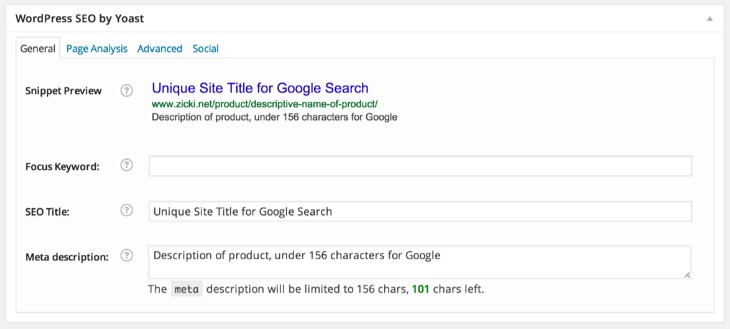
Additionally, you will want to install WordPress SEO by Yoast to maximize the SEO title for Google’s search engines. With this tool, you can optimize the Site Title to make it display differently on Google’s search engine. Perhaps you add some “Buy Now” text to your Google site title so people know they can purchase your product from that link.
As you can see, there are quite a bit to eCommerce SEO tips for selling more products.
3. Descriptive text SEO
Underneath the product’s title is an area to write information about your product. In this area, you can enter more detailed information about your product.
This is NOT to be confused with the short product description, which displays at the top of the product page. This information is optimized.
This information should feature your focus keyword in multiple places and the description’s first sentence. There should also be a lot of text and maybe some testimonials or custom-written reviews on the product in this area to flesh out the content and add value to the product.
The more time you put into the content, the more attention the content will get on Google.

4. Other areas on WordPress to optimize your keywords
Above is an image showing where to put keywords in the main content of your website, from title tags to description. Here is a complete list of places where you will want to put your eCommerce keywords:
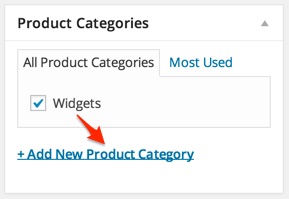
- Title tag (item #1 on the image)
- Site permalink (item #2 on the image)
- Main content or description (item #3 on the image)
- Short product description (WooCommerce feature)
- Meta description (also editable on WordPress SEO by Yoast)
- Image “alt-text”
- Image captions
- WordPress and WooCommerce tags and categories
5. Optimize the short product description of WooCommerce
The product description, in WooCommerce terms, is content that appears on the top of the page. This is where you would display quick information about your product, including your keywords!
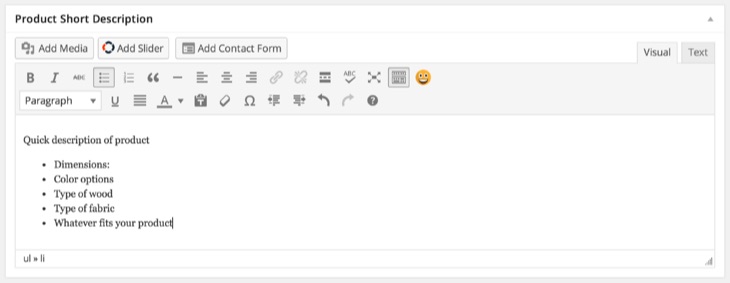
One awesome tip we picked up from the Nielsen Norman Group involves keeping your content concise and comparable.
Keep the content here limited to the keywords you want to use, perhaps a sentence or two more, and then bulleted information on the product.
If you are selling 30 different t-shirts, make sure each t-shirt has the same bulleted items in the same place (material used, sizes offered, available colors, etc.). This allows people to weave through your site. As the referenced article suggests, these small changes could increase conversion by almost 20%
“Which shirt should I buy?” is better than “Should I buy this shirt?”
6. Blogging
Another great WordPress eCommerce SEO tip? Create a blog for your website and update it regularly.
The more content you have outside of your product offerings, the more chances you have to grab customer attention from a Google search and get them on your website, where you can then sell them on your products.
Imagine that your business sold skateboards online. Here are some potential winners for blog ideas:
- Skateboards versus longboards
- How to build a skateboard
- Choosing the right wheels for your skateboard
- Black Label “Super Mex” skateboard review
Use services like Trello to create lists of blog ideas on your website so that you always have something fresh to write about.
If you’re going to get serious about blogging, make sure that your WordPress theme has plenty of different Widget Areas to place the relevant calls to action to get people to move from your blog post to a product or a shop page with many of your products.
7. Optimize page load speed of eCommerce
Think about the last time you waited impatiently for the one cashier to ring your items at a grocery store. You stamped your feet, found the next aisle or self-checkout aisle, and went over there instead.
The web is THE SAME WAY.
The more time — and we are talking fractions of a second — that a user has to wait to load your page on their computer or cell phone, the less likely they are to stay and buy your product.
Ensure your WordPress theme and plugins are lightweight and do not take long to load. Also, ensure that the host you choose will allow your website to load quickly from the server.
If you are unsure how your website is performing, consider running a test on your website using a service like GTMetrix to see what the page load speed looks like. If it is more than 3 seconds, your site is either very complicated or needs to be optimized so that users stay on the page and buy your product.
eCommerce image optimization for SEO
The motto that visuals sell should not be taken lightly. We have found that the more attractive a product image or product video looks, the more likely a customer is to take action and purchase.
Follow the tips below to optimize your images for the web and make your offering too attractive to pass up.
8. Take good quality photos!
This may sound like a no-brainer, but make sure that your image is attractive. Hire someone to take professional photography and edit your images in Photoshop to make your product look good.
All of this being said, ensure the images are optimized for the web.
Any product-featured image or another image in your WordPress gallery larger than 100KB is probably too big and will make your eCommerce SEO suffer.
9. Regenerate thumbnails plugin
If you use the free WooCommerce plugin to sell products on WordPress (recommended), you might notice that images appear blurry in product galleries.
This is a feature of WooCommerce to save on page load speed, but it can also make your images look unappealing. To fix this, an image regeneration WordPress plugin can be downloaded for free to alleviate the problem.
Download “Regenerate Thumbnails” from the WordPress repository and install it on your site. Run the program through your existing images under the Media sidebar section of WordPress. This will revert images to an acceptable thumbnail size.
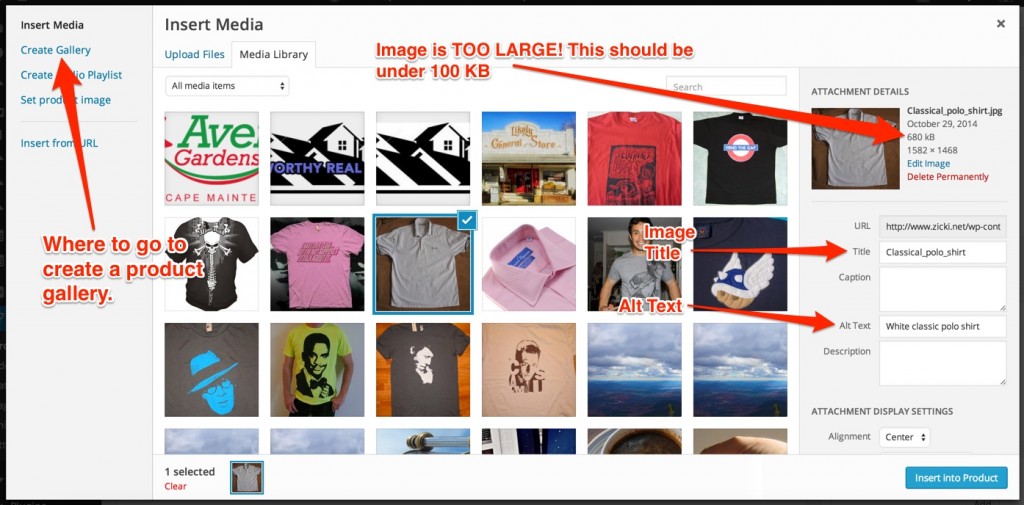
10. Optimize alt text for eCommerce
When you upload and attach images to your product, keywords are involved here too!
With images and the web, the places to optimize the keywords are in the Title and Alt Text. Make sure that your initially uploaded file has a search-engine-optimized name, and make sure that you create “Alt Text” that also taps into the long-tail keywords you want to rank for.
11. Galleries
Galleries are a great way to show more views of a product.
Thankfully, WordPress has a built-in gallery feature allowing you to upload and display multiple photos simultaneously. To access the gallery, click Add Media > Insert Gallery while editing a Product in WooCommerce.

WooCommerce also has a separate window (pictured above) to create a “Product Gallery” that will display on your site’s front page as seen on a traditional eCommerce website.
Rich Snippets
When selling products, it is also good to allow for deeper categorization, including product reviews and other textual information about your product (categories, etc.). We accomplish this with textual tools known as schema. On WordPress, there is a plugin called All in One Schema.org Rich Snippets that allows you to add this text

12. Add Product Reviews and Star Ratings

With the plugin installed, a new window will appear on the WordPress product, page, or post editor that will allow you to add Schema rankings to that content (this also works for things like external reviews)
Among the items you can address with the plugin are:
- Star rating
- Product Name
- Brand
- Price
- Currency
- Availability
13. eCommerce schema
Make sure your schema information matches the information in the product description with WooCommerce and WordPress. People can see an accurate representation of the content before and after clicking on the Google link.
Schema provides a look at the product from a Google search, enticing you to click and find out more information.
14. Share your products on social networks
Another awesome way to get attention to your site is to go social with all of your products.
You can use the popular free Jetpack plugin and the “Sharing” add-on to your product pages to add social media share buttons. Jetpack “Sharing” can automate the website to instantly share content you post on WordPress to your Facebook and Twitter accounts.
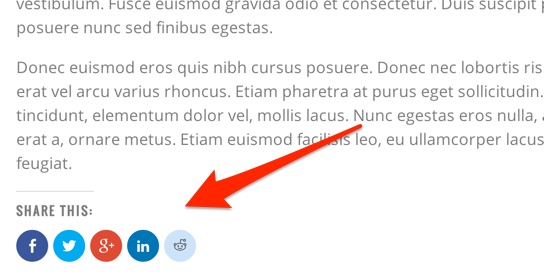
Think of all the exposure even one share on Facebook or one pin on Pinterest can get! Make sure all of your product pages feature share buttons so that people can share their positive shopping experience with the world.
15. Make your eCommerce site Mobile-Ready
This should have been number one on the list, but it can be among the more time-consuming options, so we saved it for the bottom.
More and more people are buying products on mobile devices, with many industries approaching an almost 100% increase in mobile sales last year (2014). Making sure your site is mobile-ready and designed to convert sales is critical to the shopping experience going into 2015 and beyond.
Make sure that the WordPress theme is responsive or mobile-ready.
Did you know? Going into 2015, Google will check your website to make sure it is mobile-friendly. Optimizing this will impact your search rankings as the search engine will rank mobile-ready websites more highly.
16. Building a Landing Page for Checkout
It has been proven that people love putting products in a shopping cart to have it in their “possession” momentarily. They will dream and then click off somewhere else.
Can you blame them? Putting the product in your cart was an impulse from the start. And now you can go back to other products, compare, visit a blog, click an item in the sidebar, etc.
Make sure that major sales landing pages are displayed on either a “Full-Width” or “Landing Page” template.
- Full-width pages have no sidebar but include a header and footer for navigation.
- Landing pages (best for a checkout) have nothing except for the content on the page.
Using these templates prevents users from finding easier ways to click off the checkout page and results in more sales.
Want a quick case study? We changed to a full-width page without a sidebar for one of our theme offerings and conversion increased by over 3%. The change was simple and increased sales!
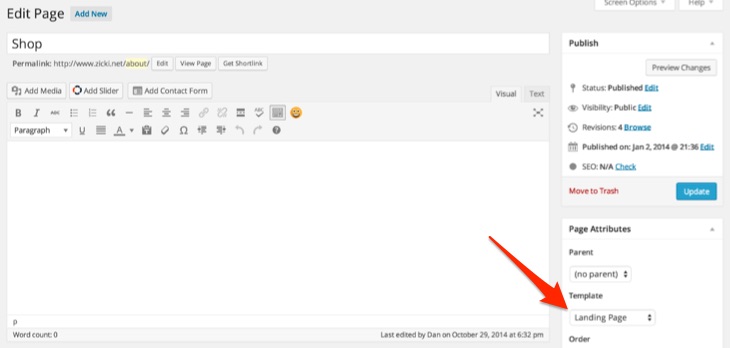
To create a splash page in full width or landing page templates with our themes, you can select the type of page you would like it to be from the sidebar as you edit content.
17. eCommerce Local SEO and Link Building
Plenty of businesses out there cannot ship products for various reasons but would love to have a better eCommerce presence to allow clients to place online orders for pickup or delivery.
This falls under the category of local SEO, and there are a few tips you can use to optimize your site for your local area:
- Focus keywords around the location (city/area of the world/popular local venues)
- Set up a Google Places profile and keep it updated
- Set up and maintain a Yelp! profile
- Share your newest product offerings on social media
- Link your site with complementary or friendly businesses in the area.
- Get involved with local events and ask to share site links
Get a WooCommerce theme and start optimizing
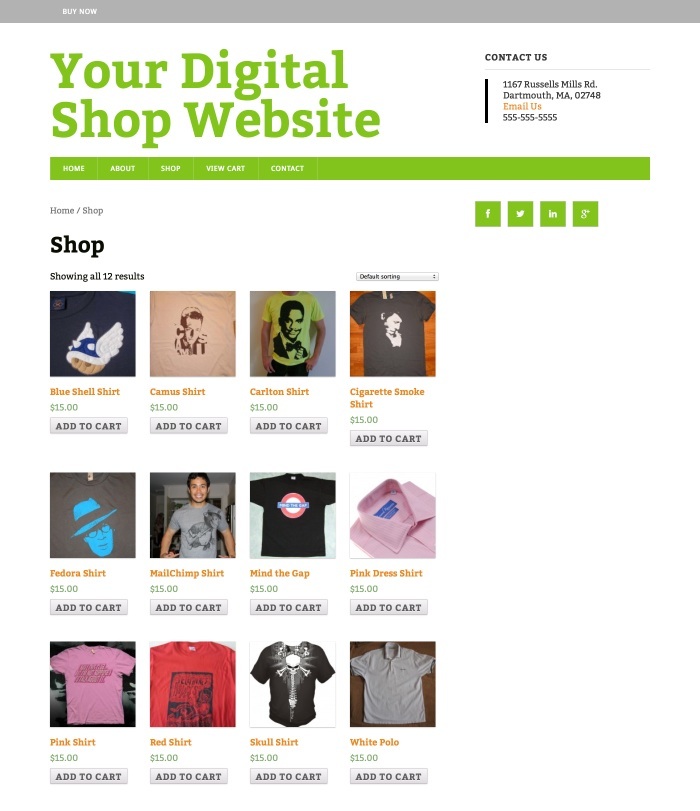
With all these tools, you should be confident in developing your site and increasing conversions.
- Install our themes (styled to work with WooCommerce)
- Set up WooCommerce to sell some products
- Follow these tips
- Watch your sales numbers increase.
Cut to the chase!
Here is a video reviewing many of the elements discussed on the page from our SEO Lunch series.
If you have any questions or tips, please get active below in the comments!
We hope that you enjoy our content. If you decide to make a purchase after clicking on one of our affiliate links, we’ll earn a small commission at no extra cost to you. Thanks for reading! View our Affiliate Disclosure


Pingback: Weekly Roundup: December 26, 2014 – Sell with WP
We just finished article writing on google’s latest algorithm change regarding using mobile friendly as a signal for search engine ranking and how it is becoming more important to follow google’s basic site design guidelines. Your post was a great in terms of averall serch engine improvement and will be very useful to small store owners to understand what exactly SEO is?
Really nice tips. It will help to promote our website in better way. Thanks guys for sharing!
Good stuff, Dan. I really like the tips regarding review/schema. Its amazing how so many WP ecommerce sites are not doing it.
Keep up the good work!
Pingback: The Ultimate Guide To eCommerce Link Building | WooGuru Blog